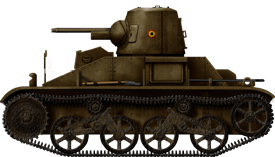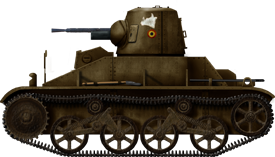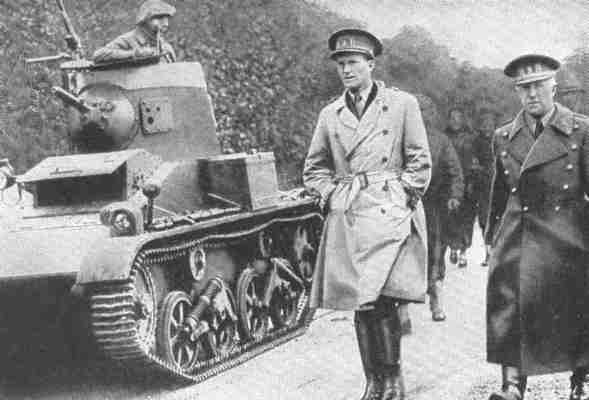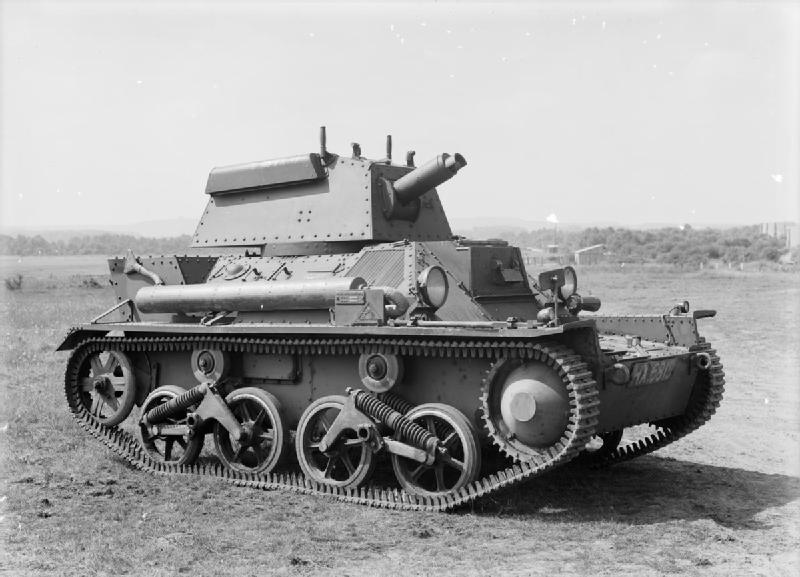History of the T15 light tank
During the motorization program of the Belgian Army it was decided to buy tracked armored vehicles in order to equip the newly created “Chasseurs Ardennais”. The Vickers-Carden-Loyd Model 1934 (or "4 ton") tankette was chosen. 42 were ordered (in two batches). The first 18 units were ordered on the 10th of March 1934, and delivered in two lots of 9, in February 1935, on the 15th and 22nd respectively. The second batch (24 units) was ordered on 16th April 1935 and they were delivered between the November 15 and December 28, 1935. During the trials it was shown these vehicles had the required agility and speed to fulfill the specifications. Belgium at that time followed a strict neutrality policy and avoided buying heavier tanks which could be seen as a provocation by the Third Reich.Design
Generally similar to the British Light Mk.III/IV. The vehicles were delivered according to the issued specifications, including a special conical turret and no weapons. The FRC (Fonderie Royale de Canons) was given the task to fit inside a 13.2 mm Hotchkiss heavy machine gun, which were initially bought for the Aeronautique Militaire, and were light enough for the tankette. Compared to the British equivalent it was a much more potent armament, capable to pierce through 13 mm of armor at 500 m (0.51 in at 1640 ft), enough to destroy any armored cars and many light tanks of the time, including the German Panzer I.There was no coaxial armament. However, some T15 were also fitted with a support on the turret for a FN-Browning FM-30 automatic rifle, for antiaircraft defense.The hull was partly welded and made of riveted plates, 7 to 9 mm thick (0.27-0.35 in), which was fairly light and did not provide sufficient protection against heavy machine guns and most light anti tank guns and rifles of the time. However, combined with the British gasoline 90 hp Meadows EAST water-cooled engine, the speed was remarkable (64 km/h, 39.76 mph), even by tankette standards This was perfectly suited for cavalry tactics. The tracks comprised four twin rubberized road wheels, on two bogies. The drive sprocket was at the front, idler at the rear. Steering was performed through brake levers. As usual however for British tankettes fitted with the same scissors type suspensions, the forward pitch when braking was somewhat excessive and prevented any immediate aiming. Traverse was electric.
The T15 in action
Lightning fast, but poorly protected and lacking firepower, the T15 was only marginally better than an armored car, with off-road capabilities but lacking a radio. Their speed made them more difficult to pick up and fire at, but tactically they were spread out in "penny packets" in various cavalry units, according to French tactics at the time. They were completely outclassed and outnumbered by the Germans, applying the "Schwerpunkt" tactic. These small units were destroyed and swallowed by the German onslaught in a few days. By the end of June most had been destroyed and those remaining were later captured, serving as the Panzerspahwagen VCL 701(b)(Reconnaissance light tank). They probably never left Belgium.Units Repartition
- 1er Guides (1DC): 4 T15
- 2eme Lanciers (1DC) : 6 T15
- 3eme Lanciers (1DC) : 6 T15
- 1er Lanciers (2 DC) : 6 T15
- 1er Chasseurs à Cheval (2 DC) : 6 T15
- 2e Chasseurs à Cheval (2 DC) : 4 T15
- 1er Chasseurs Ardennais : 3 T15
- 2eme Chasseurs Ardennais : 3 T15
- 3eme Chasseurs Ardennais : 3 T15
- Ecole automobile : 1 T15
Links about the T15
On WikipediaOn WWIIvehicles.com
| T15 light tank specifications | |
| Dimensions (L-w-h) | 3.63 x 1.89 x 1.90 m (11.9 x 6.2 x 6.23 ft) |
| Maximum total weight | 3.8 short tons |
| Crew | 2 (commander/gunner, driver) |
| Propulsion | Meadows-Est 6 cyl., 90 bhp@500rpm |
| Speed | 64 km/h (road) (39.76 mph) |
| Range | 230 km (142.91 mi) |
| Armament | FRC 13mm(0.5in) Heavy Mg. AA 7.65mm FM M30 |
| Armour | From 7 to 9 mm (0.27-0.35 in) |
| Total production | 42 between 1936-1938 |

T15, presumably of the 2nd Lanciers, Gembloux area, May 1940, courtesy of Georges Coninckx.

T15 of the Chasseurs Ardennais, recognizable by their Ardennes wild boar emblem. The gun has no protective mantlet.
Gallery

A famous photo : King Leopold reviewing his light armoured forces on 22 may 1940 with General Denis. A line of T-15s could be seen.

Vickers Light tank Mark III, 5-ton class. The T-15 was based on this model.

WW2 Tanks




























WW2 tanks posters

All Tiger tanks liveries.

Panther liveries and variants

WW2 Armour - All tanks











Tanks aces and single tanks series

Find more there

Museums, Movies, Books & Games
The Tanks and Armor in pop culture
Tanks and armored vehicles in general are only really grasped when seen first person: The mass, the scale, it's all there. Explore also the way tanks were covered in the movie industry, in books and in video games.Movies:
Best tanks movie on warhistoryonline.com
On imdb.com
On bestsimilar.com/
miltours.com
liveabout.com/
watchmojo.com
Video Games:
pcgamesn.com
historyhit.com
levvvel.com
vg247.com/best-tank-games
mmobomb.com/
alienwarearena.com

